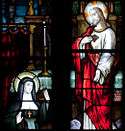Christian pilgrimage

Christianity has a strong tradition of pilgrimages, both to sites relevant to the New Testament narrative (especially in the Holy Land) and to sites associated with later saints or miracles.
History
The first pilgrimages were made to sites connected with the ministry of Jesus. Aside from the early example of Origen, who "in search of the traces of Jesus, the disciples and the prophets",[1] already found local folk prompt to show him the actual location of the Gadarene swine in the mid-3rd century, surviving descriptions of Christian pilgrimages to the Holy Land and Jerusalem date from the 4th century. The Itinerarium Burdigalense ("Bordeaux Itinerary"), the oldest surviving Christian itinerarium, was written by the anonymous "Pilgrim of Bordeaux" recounting the stages of a pilgrimage to Jerusalem in the years 333 and 334.[2] Pilgrimage was encouraged by church fathers like Saint Jerome and established by Helena, the mother of Constantine the Great. Pilgrimages also began to be made to Rome and other sites associated with the Apostles, Saints and Christian martyrs, as well as to places where there have been apparitions of the Virgin Mary. Pilgrimage to Rome became a common destination for pilgrims from throughout Western Christianity in the medieval period, and important sites were listed in travel-guides such as the 12th-century Mirabilia Urbis Romae.
In the 7th century, the Holy Land fell to the Muslim conquests,[3] and as pilgrimage to the Holy Land now became more difficult for European Christians, major pilgrimage sites developed in Western Europe, notably Santiago de Compostela in the 9th century.
Political relationships between the Muslim caliphates and the Christian kingdoms of Europe remained in a state of suspended truce, allowing the continuation of Christian pilgrimages into Muslim-controlled lands, at least in intervals; for example, the Fatimid Caliph al-Hakim bi-Amr Allah ordered the destruction of the Church of the Holy Sepulchre, only to have his successor allow the Byzantine Empire to rebuild it.[4] The Seljuk Turks now systematically disrupted Christian pilgrimage routes, which became one of the major factors triggering the crusades later in the 11th century.
The crusades were at first a success, the Crusader states, especially the kingdom of Jerusalem, guaranteeing safe access to the Holy Land for Christian pilgrims during the 12th century, but the enterprise of the crusades was ultimately doomed to failure, and the Holy Land was entirely re-conquered by the Ayyubids by the end of the 13th century.
Under the Ottoman Empire travel in Palestine was once again restricted and dangerous. Modern pilgrimages in the Holy Land may be said to have received an early impetus from the scholar Ernest Renan, whose twenty-four days in Palestine, recounted in his Vie de Jésus (published 1863) found the resonance of the New Testament at every turn.
Contemporary youth gatherings as Roman Catholic "pilgrimages"
World Youth Day is a major Catholic event, specifically for young people. It is held internationally every two to three years. In 2005, it was held in Cologne, Germany. In 1995, the largest gathering of all time was to World Youth Day in Manila, Philippines, where four million people from all over the world attended.[5]
In the media both gatherings are usually referred to as 'pilgrimages', but actually in the strict meaning of the word they are not pilgrimages as they are (each time) once-only religious gatherings for a specific purpose (funeral, religious renewal for the youth) and not focused at a shrine based cultus-object for veneration. However, since the funeral, the proper grave of John Paul II is actually indeed becoming a new site of pilgrimage in Rome.
See also
- Great German Pilgrimage of 1064–1065
- HCPT – The Pilgrimage Trust
- List of Christian pilgrimage sites
- List of pilgrimage churches (containing, as of March 2016, only Catholic sites)
- New Testament places associated with Jesus
- Stations of the Cross and Statio
- Via Dolorosa
References
- ↑ Quoted in Robin Lane Fox, The Unauthorized Version, 1992:235.
- ↑ General context of early Christian pilgrimage is provided by E.D. Hunt, Holy Land Pilgrimage in the Late Roman Empire AD 312-460 1982.
- ↑ Wickham Inheritance of Rome p. 280
- ↑ Pringle "Architecture in Latin East" Oxford History of the Crusades p. 157
- ↑ "World Youth Day". Retrieved 10 March 2011.
|first1=missing|last1=in Authors list (help)
External links
- Database of Shrines and Pilgrimage in the Netherlands
- Galilean Destinations for Christians
-
 Herbermann, Charles, ed. (1913). "On Pilgrimages". Catholic Encyclopedia. New York: Robert Appleton Company.
Herbermann, Charles, ed. (1913). "On Pilgrimages". Catholic Encyclopedia. New York: Robert Appleton Company.
